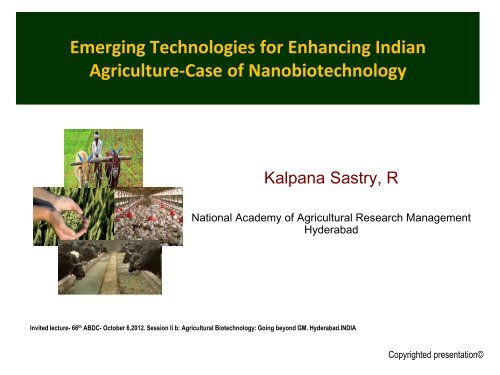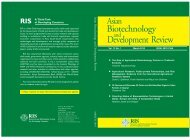Dr. (Mrs.) R. Kalpana Sastry - Research and Information System for ...
Dr. (Mrs.) R. Kalpana Sastry - Research and Information System for ...
Dr. (Mrs.) R. Kalpana Sastry - Research and Information System for ...
Create successful ePaper yourself
Turn your PDF publications into a flip-book with our unique Google optimized e-Paper software.
Emerging Technologies <strong>for</strong> Enhancing Indian<br />
Agriculture-Case of Nanobiotechnology<br />
<strong>Kalpana</strong> <strong>Sastry</strong>, R<br />
National Academy of Agricultural <strong>Research</strong> Management<br />
Hyderabad<br />
Invited lecture- 66 th ABDC- October 6,2012. Session Ii b: Agricultural Biotechnology: Going beyond GM. Hyderabad.INDIA<br />
Copyrighted presentation©
• Introduction<br />
Plan of Presentation<br />
• Emerging Sciences <strong>for</strong> Agricultural Development <strong>and</strong> Challenges<br />
• Framework <strong>for</strong> Assessing Nanobiotechnology<br />
• Current trends of work in agri-nano biotechnology<br />
• Concluding Remarks<br />
Copyrighted presentation©
Indian Agriculture – Recent Concerns<br />
• Transition –<br />
– from traditional farming patterns yielding less than 0.5 t/ha in the<br />
1950s to more technology-driven systems yielding 4 t/ha<br />
• But decline<br />
– in contribution of agriculture <strong>and</strong> allied sectors in GDP<br />
– steady decline in farm incomes <strong>and</strong> enhanced rural distress<br />
• Compounded by degradation of the natural resource base<br />
• National policy goal of 4% growth in agriculture<br />
– Warrants effective use of improved technologies in the rural sector<br />
through ensuring the continuous flow of new technologies<br />
Copyrighted presentation©
Nanoscience to Nanotechnology<br />
• Leads to creation of improved materials, devices <strong>and</strong><br />
delivery systems at molecular level<br />
• Set of technologies at nanometre scale, not a<br />
single technological field.<br />
• Application areas: Materials, Electronics, Optoelectronics,<br />
Medicine, Biotechnology, Measurements, Manufacturing,<br />
Environment, Energy, agriculture <strong>and</strong> food.<br />
Copyrighted presentation©
Challenges <strong>for</strong> Integration of ET<br />
• Increasing costs <strong>for</strong> R&D,<br />
• Shortage of trained manpower<br />
• Policy framework <strong>for</strong> integrating the new<br />
technologies into applications across the<br />
agri-value chain<br />
Copyrighted presentation©
Objective(s) of this study<br />
• Address emergence of nanobiotechnology<br />
• Integration <strong>and</strong> institutionalization in the<br />
Indian agricultural l<strong>and</strong>scape<br />
• Through exploring the current<br />
technological innovations<br />
– in nanobiotechnology <strong>and</strong> underst<strong>and</strong> their<br />
possible role in enhancing agricultural<br />
productivity<br />
Copyrighted presentation©
Nanobiotechnology<br />
• Against a premise that nanobiotechnology<br />
– uses NT concepts <strong>and</strong> tools <strong>for</strong> studying the basic foundations of<br />
biology or developing biological (?)/medical procedures<br />
– proposes engineering methods <strong>for</strong> construction of biological<br />
molecules with the functions that differ essentially from their<br />
natural functions<br />
– uses NT tools/approaches <strong>for</strong> manipulations with materials that<br />
differ from previously known synthetic or biochemical methods,<br />
being applied during in biological practice<br />
Copyrighted presentation©
Sectors of Agri-<br />
Biotechnology<br />
Green Biotechnology<br />
Veterinary Biotechnology<br />
Food Biotechnology<br />
Blue Biotechnology<br />
White Biotechnology<br />
Environmental Biotechnology<br />
Interventions Tools of<br />
Nanotechnology*<br />
Nanobiotechnology<br />
Agri-nanobiotechnology<br />
Agri-Production <strong>System</strong>s<br />
Food Security<br />
Nutrition Security<br />
Livelihoods Security<br />
Ecological Security<br />
Agro-biodiversity conservation<br />
* Nanoparticles/Quantum Dots/Carbon nanotubes/ Dendrimers / Fullerenes /Biosensors / Diagnostic kits/MEMS/Biochips/ Microfluidics / Nanofluidics /Smart delivery<br />
systems/Nanofilteration/Nanospheres/Nanofibres/Nanowires<br />
Use of science-based interventional tools at a nanoscale in the agri-value chain<br />
under the canvas of agri nanobiotechnology<br />
Copyrighted presentation©
Challenging<br />
• Most research in nanobiotechnology is at<br />
an early-stage<br />
– Its application to agricultural production systems<br />
– is probably still at a conceptual level to permit realistic<br />
assessments<br />
• In such situations,<br />
– analysis of patents granted in the area <strong>and</strong> related areas<br />
have often been used <strong>for</strong> making assessments about<br />
emerging technologies<br />
Copyrighted presentation©
Methodology<br />
• Base data collected through empirical<br />
research methods<br />
• Technology roadmapping <strong>and</strong> database<br />
management concepts<br />
– used to develop a framework<br />
– to map the potential of these technologies against the<br />
current gaps of knowledge in agri-nano-biotechnology<br />
– Patents used R&D indicators<br />
Copyrighted presentation©
Patent Analysis<br />
• Growth <strong>and</strong> accumulation of patents in a new<br />
area of technology considered<br />
• as indicating directions <strong>for</strong> subsequent investments<br />
<strong>and</strong> related product/process innovations<br />
• Patent analysis<br />
• assess current status <strong>and</strong> trends in technology development<br />
• classify <strong>and</strong> map the technology to relevant application areas <strong>for</strong><br />
strategic planning<br />
Copyrighted presentation©
Methodology<br />
• St<strong>and</strong>ardized search methodology, <strong>and</strong> a<br />
technology-based process methodology<br />
– Used to search, assemble <strong>and</strong> characterize available patent<br />
in<strong>for</strong>mation in nanoresearch areas<br />
• Set of 469 patents with implications <strong>for</strong> agrinanobiotechnology<br />
retrieved<br />
• Analysis of whole text patent documents based<br />
on description <strong>and</strong> background of the invention<br />
indicated<br />
– five possible areas<br />
Copyrighted presentation©
Broad Areas of Application Biotechnological Tools in<br />
Agriculture<br />
S. No Areas<br />
I Genomics<br />
II Genetic Engineering<br />
III Genetic Trans<strong>for</strong>mation<br />
IV Therapeutics<br />
V Bio-industry<br />
Copyrighted presentation©
Indicative Areas of Nanoresearch<br />
Nanoresearch<br />
Area<br />
Potential Application in Nanobiotechnology<br />
• Nanofibre DNA analysis<br />
DNA sequencing<br />
Nanofilteration to obtain ultra- dense fermentation broth<br />
<strong>for</strong> cell cultures<br />
Post-harvest technology, e.g. nanofilteration <strong>for</strong><br />
production of oiligosaccharide rich syrups<br />
• Nanoprobe DNA sequencing<br />
• Graphene<br />
nanoribbon<br />
DNA sequencing<br />
• Nanosphere Transfection with expression vectors<br />
Gene therapy<br />
Copyrighted presentation©
Indicative Areas of Nanoresearch-II<br />
Nanoresearch Area Potential Application in Nanobiotechnology<br />
• Nanobeads Nanovaccines<br />
DNA vaccines<br />
• dendrimers Diagnoses, treatment <strong>and</strong> eradication of malignant tumors in<br />
small animal populations<br />
• Quantum dots Genetic analysis<br />
<strong>Dr</strong>ug discovery<br />
Disease diagnostics<br />
• Buckyballs <strong>Dr</strong>ug delivery<br />
• Carbon<br />
nanoparticles<br />
Enzyme based biofuel production<br />
Copyrighted presentation©
Knowledge Mapping Framework <strong>for</strong> Integration of Biotechnology with Nanoresearch Areas<br />
1.<br />
Copyrighted presentation©
Prospective area of<br />
agri-biotechnology<br />
Advantages of incorporating<br />
nanobiotechnologies<br />
Genomics DNA sequencing:<br />
High throughput<br />
Enhanced accuracy<br />
Relatively less time<br />
Operates on a small scale<br />
More reliability<br />
Genetic engineering Not host specific<br />
Increased recovery of viable trans<strong>for</strong>med<br />
cells<br />
Increased gene expression<br />
Sustained release of encapsulated DNA<br />
Non-dissociation of plasmid DNAnanoparticles<br />
during various steps of<br />
transfection<br />
Cell cultures substrate mimics 3dimensional<br />
in-vivo cell growth<br />
Indicative future applications<br />
Genome sequencing project<br />
can be extended to wild <strong>and</strong><br />
weedy species which are the<br />
source of resistance genes to<br />
several biotic <strong>and</strong> abiotic<br />
stresses<br />
Enhancing agrobiodiversity<br />
conservation<br />
Greater efficacy of the<br />
technique with assured results<br />
Copyrighted presentation©
Prospective area of agribiotechnology<br />
Advantages of incorporating<br />
nanobiotechnologies<br />
Genetic trans<strong>for</strong>mation Particle mediated DNA delivery<br />
;Enhanced surface area of<br />
nanopaticles;<br />
Greater <strong>and</strong> uni<strong>for</strong>m adsorption of<br />
DNA to nanoparticles<br />
Therapeutics Minimal toxic side effects to normal<br />
cells with gene therapy<br />
Direct in-vivo gene transfer devoid of<br />
viral vectors <strong>for</strong> gene therapy<br />
Greater interaction of the nanodrugs<br />
with cells, proteins <strong>and</strong> viruses<br />
Efficient targeted drug delivery<br />
Bioindustry Enhanced processing of post-harvest<br />
material<br />
Enzyme based biofuel production<br />
with increased speed of electron<br />
transfer between the electrodes<br />
without needing a mediator molecule<br />
Indicative future applications<br />
Transgenics in non-food<br />
species such as fibre crops<br />
<strong>and</strong> draught animals <strong>for</strong><br />
enhancing rural income<br />
Assured plant <strong>and</strong> animal<br />
health care<br />
Reduced environmental<br />
pollution with the efficient use<br />
of bioenergy based fuel<br />
ensuring ecological security<br />
Copyrighted presentation©
Potential of NBT in Agriculture<br />
• Study indicates potential application of nanoscience<br />
based processes <strong>and</strong> products in biotechnology with<br />
applications in agricultural systems<br />
• The type of drivers of technological changes identified in<br />
various sub areas of nanobiotechnology can <strong>for</strong>m base<br />
<strong>for</strong> major trajectories in technology development<br />
• Most research at early-stage levels<br />
• But offers several opportunities <strong>for</strong> applications<br />
– In agricultural systems to enhance productivities, conserve agro-biodiversity,<br />
improve quality of products <strong>and</strong> also catalyse ecological security of fragile<br />
ecosystems<br />
Copyrighted presentation©
• Precautionary approach advocated<br />
globally<br />
ELHS Approach<br />
• R &D at the nanoscale, nanotechnology<br />
applications <strong>and</strong> societal implications<br />
– <strong>for</strong>m a coherent <strong>and</strong> interactive system, which<br />
schematically may be visualized as a closed loop<br />
• Nanotechnology success is determined<br />
• by an architecture of factors<br />
– such as creativity of individual researchers, training<br />
of students in nanoscale science <strong>and</strong> engineering,<br />
– connections between organizations,<br />
– patent regulations, physical infrastructure,<br />
– legal aspects,<br />
– state <strong>and</strong> federal policies,<br />
– <strong>and</strong> the international context.<br />
• The success of nanotechnology cannot<br />
be determined only by doing good R&D in<br />
academic <strong>and</strong> industry laboratories!<br />
A closed loop.<br />
Source: Roco 2003.<br />
Copyrighted presentation©
Occupational Hazards<br />
Ecosystem<br />
Sources/Routes of Exposure<br />
Environment<br />
Source: Royal Society Report,2004<br />
Consumer<br />
Copyrighted presentation©
Evidences - Translocation of Nanoparticles in nontargeted<br />
areas<br />
• Deagglomeration, translocation, <strong>and</strong> distribution reported to play<br />
key roles in the fate of NPs once they gain entrance into the human<br />
body<br />
– NPs, which are smaller than 20 nm, can transit through blood vessel walls.<br />
– Magnetic nanoparticles, <strong>for</strong> instance, can image metastatic lesions in lymph<br />
nodes, because of their ability to exit the systemic circulation through the<br />
permeable vascular epithelium (Bogdanov et al., 2005)<br />
• Some NPs indicate tendency to penetrate the blood-brain barrier<br />
through paracellular movement, passive diffusion, transport <strong>and</strong><br />
endocytosis (Lockman et al., 2003; Kreuter, 2004).<br />
Copyrighted presentation©
Responsibilities of <strong>Research</strong>ers<br />
• A need to be develop code of conduct<br />
• Initial studies (started since 2007-08 only)<br />
indicate technical competence with<br />
sensitive ethical compass : a required<br />
element of all NT researchers<br />
• 13 specific ethical responsibilities at 3<br />
levels identified [ McGinn.2010.]<br />
Copyrighted presentation©
Suggested Approaches<br />
• Current approaches to risk management <strong>for</strong> engineered<br />
nanomaterials,<br />
– engineering control,<br />
– Administrative control,<br />
– PPE <strong>and</strong> health surveillance,<br />
• Parallel approaches already in practice in occupational health <strong>and</strong><br />
biosafety<br />
• Further research <strong>and</strong> investigation is needed to evaluate the<br />
effectiveness of these approaches<br />
– across the spectrum of engineered nanomaterials being used <strong>and</strong> generated in<br />
laboratories <strong>and</strong> industry.<br />
• For agri-nanotechnologies-<br />
.<br />
– farmer /usergroups interaction a must<br />
– With an aim to identify the risk implications of nanotechnology <strong>for</strong> worker health,<br />
– <strong>and</strong> to devise ways to protect workers/farmers/end users<br />
– from any identified adverse health effects of working with nanomaterials by<br />
developing novel approaches to risk assessment <strong>and</strong> management.<br />
Copyrighted presentation©
Suggested Approaches<br />
• Move away from generalised discussions<br />
– towards a recognition of case specific differences<br />
• Encourage better characterisation of nanomaterials with<br />
– Requirement of reporting on their use<br />
• Increase funding <strong>for</strong> research<br />
– on (eco)toxicology <strong>and</strong> environmental fate <strong>and</strong> behaviour<br />
• Use lifecycle perspectives when considering environmental impacts<br />
• Develop international st<strong>and</strong>ards flexible enough<br />
– to adapt to new methods <strong>and</strong> findings<br />
• Include social <strong>and</strong> ethical considerations in policy making, especially<br />
in the framing of priorities <strong>for</strong> risk research<br />
• Commit to environmentally sustainable <strong>and</strong> socially robust<br />
innovation<br />
Copyrighted presentation©
Developing Safe agri-<br />
Nanobiotechnologies through<br />
Sound Science<br />
Thank you<br />
R.<strong>Kalpana</strong> <strong>Sastry</strong><br />
kalpana@naarm.ernet.in<br />
Copyrighted presentation©



